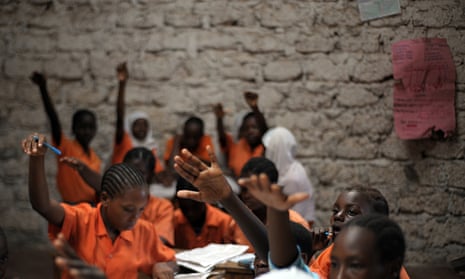More than 260 million children worldwide are out of school, yet more than half of those in education are not learning, the World Bank has warned.
The global push to ensure free primary and secondary education by 2030 has helped fuel a “trade-off of quality for quantity”, whereby children are spending several years in school yet remain unable to read, write or do basic sums, according to Jaime Saavedra, who leads the global education practice at the bank.
“This is a learning crisis, and we call it a crisis because we need to recognise the magnitude of the problem: it is extremely large,” Saavedra told the Guardian.
“We are in deep trouble, because we are extremely far from where we should be. We have hundreds of millions of children who are in school who are not learning.
“If you take the average [figures] from developing countries for which we have data, about 56% of the kids who are in school are not learning. In sub-Saharan Africa, the number is about 90%. It’s an overwhelming problem.”
On Friday, a high-level education financing conference will convene in Dakar, Senegal, with the aim of raising $3bn (£2.1bn) to support the education of 870 million children in the 89 countries where 78% of the world’s out-of-school population live.
The Global Partnership for Education – a multilateral organisation comprised of governments, foundations and private donors – is also expected to push poorer countries to increase their domestic education expenditure to 20% of national budget.
Despite a universal pledge to ensure free primary and secondary education by 2030, governments are largely failing to address adequately key issues associated with learning, such as the cost of uniforms, transport to and from school, and lodging, activists claim.
The cost of food, clothing, stationery and books means families are often unable to afford to send their children to school even if tuition is free, said Lucy Lake of the Campaign for Female Education (Camfed), a Cambridge-based organisation dedicated to the education of girls and young women in Africa.
Lake said: “The notion of free secondary education can overshadow some of the costs that are still very real for the most marginalised children – especially girls – and unless there are targeted mechanisms to ensure those needs are met, those girls will continue to be excluded from the system, or, if they are in the system, marginalised within the system.”
Children’s lack of access to school, the failure of schools to retain their students, and the “learning crisis” are key problems that the global community needs to address to meet educational targets, say campaigners. According to Unesco, 264 million children are out of school for the third year running.
“Low-income countries have made meaningful progress in ensuring primary education, but secondary education still remains out of reach for millions of children,” said Elin Martínez, children’s rights researcher at Human Rights Watch (HRW).
“Countries that have pledged to provide free secondary education should make good on these promises and those that have not, should follow suit.”
Only half of all developing countries have the metrics to measure learning at the end of primary and lower-secondary school. Without those tools, it is nearly impossible to chart schools’ progress or rate national policy on education. Experts have warned that the “learning crisis” is widening social gaps instead of narrowing them, as young adults emerge from school without basic life skills.
Senegal, which is co-hosting the funding conference with France, provides free education for children aged between six and 16, yet research by HRW found that government secondary schools were charging annual fees of more than 50,000 francs (£67), forcing many students to drop out.
All governments attending the conference should make a legally binding pledge to support free education, said Martínez.
“Governments serious about meeting their education commitments for all children will need to show how they plan to make fully free primary and secondary education a reality.”
Last year, the international development committee pushed Britain to tackle the global learning crisis by boosting its spending from 8% to 10%. Evidence presented to the committee showed the average spend on each child in low- and middle-income countries to be less than $10 a head annually.
New research shows that for every $100 spent on girls’ education through the Camfed programme, the impact is equivalent to two extra years in school. The programme, which is supported by the Department for International Development, focuses on secondary schooling for girls from marginalised communities in Tanzania.
Bursaries aimed at helping students in key areas play a crucial role in getting and keeping children – particularly girls – in school, said Lake. “We need to develop targeted financing mechanisms for these [everyday] costs, such as decent clothing, just for a girl to be able to walk through the school gates and participate in class without feeling ashamed, which puts her on the back foot.”
